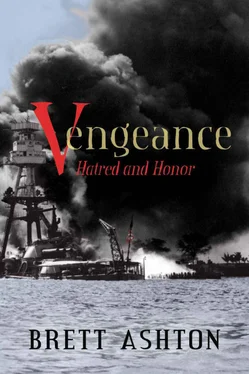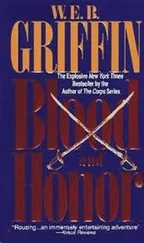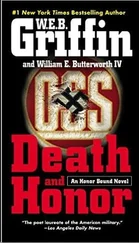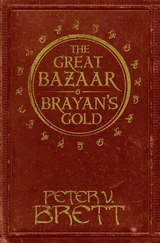Apparently, one of the other ships saw all of the smoke coming from our guns and thought we had been hit.
Where I was, I had a clear view of what was going on, and it wasn’t pretty. All the anti-aircraft guns were blazing at their full fury, trying to fight off the attack. I had never seen anything like it before. Indeed, the Showboat was proving her worth in combat, but the question still remained: “Would it be enough?”
Several more Jap planes slipped through. One made a dive on the Enterprise and released a bomb. I watched as it sailed down and struck the ship on the aft part of the flight deck. Several seconds later, boom , an orange fireball and black smoke rose into the sky above her.
I continued to watch the damaged carrier in brief glimpses as I frantically worked to do my job. “ Bridge, Enterprise has been hit! ” I shouted into the phones. A large column of black smoke begin to pour out of the big E; I didn’t have to imagine what was going on over there. I knew all too well, and while I was sympathetic to their plight, all I could do is hope we wouldn’t be next.
Just then, a Zero broke through and began a strafing run towards us. I would have to guess he was coming down as an attempt to identify us, being that the Japs had never seen a battleship like the North Carolina in the American fleet before. It seemed to me he had to be pretty suicidal to even attempt to get as close to us as he was getting.
“ Get that Nip out of my sky! ” I shouted at the machine gun officer as I reached for my own forty-five, drawing it out of its holster and flipping the safety off. He was coming in very fast and low, with a stream of tracer fire erupting from the guns of his aircraft. Below me on the main deck, a dozen smaller fifty-caliber and twenty-millimeter machine guns spun around and sent a stream of tracers back to greet him. I could see the expression on his face as he approached over the forward part of the ship and below my position in Sky Control.
It was now or never, so I decided to take my shot. I leveled the sights of my Colt at the canopy and pulled the trigger over and over until it went empty. Any sound my gun made was insignificant next to those of the Showboat , and the only way I knew it fired at all was because of the way it jumped in my hands from the recoil.
Now you may think me a little bit touched in the head by my old age or something. Or maybe I’m just an “old salt” telling sea stories. And that’s alright. But exactly when I fired the sixth round, several things happened. A bullet hole appeared in the Zero’s canopy, blood splattered on the glass, and the Jap pilot convulsed and slumped forward.
About a half a second later, large chunks of the structure of the aircraft began getting blown off from the Showboat ’s guns, striking the plane. Smoke streamed from the engine and then flames until it hit the water off of the starboard side. Now, I know the gunners of the North Carolina shot that plane down, and I can understand how you could think I’m just an old man telling sea stories, but I also know I killed that pilot.
We only had to wait about thirty seconds for the next hit on Enterprise . This explosion was bigger, as if it hit a powder magazine or something, followed by several secondary explosions. The fireball was tremendous. I could tell she was beginning to pick up a list. It’s very easy to see on a carrier at any angle because of the large flat top.
Again, we didn’t have to wait long for another hit on Enterprise . Maybe two minutes. The third hit was amidships by the island structure. Even more smoke poured out of the ship.
Then, without warning or any obvious reason, the Enterprise turned hard to starboard. Several smaller ships had to evade to keep from being run over. She was hard over and running at full speed, out of control. She began to list so far that aircraft just started falling over the side. She had obviously lost her rudder controls, and they slammed into the full starboard position.
It wasn’t much longer when the Japanese attack ended, and they began to withdraw. The order was given to cease fire. As rapidly as the overwhelming noise from the Showboat began, it ended, and the following relative quiet was as stark as the noise had seemed. I looked at my watch and noticed the entire attack only took seven minutes.
Some forty minutes passed with the Enterprise still turning circles before their steering problems were corrected. Most of the fires were put out fairly soon as well, but it was still easy to tell she was having some difficulty. We stood by, doing circles right along with her, guarding against the possibility of another air attack. We did expect another wave of Japs.
There was only light damage from enemy strafing and one casualty, but it was pretty obvious the Enterprise would not survive another attack. She was beat up pretty bad, and we expected the second wave within a few hours.
Later on, our radar did pick up another large wave of enemy planes to the southwest of us. It was right about where we would have been had the Enterprise ’s steering not failed. Evidently the Japanese did not spot us again because a second attack never materialized.
By the end of the battle, the Japs had lost a small aircraft carrier and at least seventy planes with experienced crews, which I was sure they could not afford to lose. The North Carolina was credited with seven kills and assisted with many more. And just as importantly to the overall strategy of the war, Guadalcanal remained in American hands.
After the battle, everything about the performance of the crew changed. They understood a lot more of what they were up against and pulled together in a way I had never seen on any other ship I had served on before.
A lot of us got tattoos of that date on our forearm. You can still see mine right here. It’s become a little fuzzy over the years, but I had never before been more proud to serve on a ship than I had on that day.
Later on, I was giving my report to the XO about my observations of the battle. Things went generally well, actually remarkably well, considering the relatively weak compliment of automatic weapons the ship had at that time.
Later on in the war, the North Carolina ’s host of anti-aircraft weapons would be expanded considerably, as it would be for the rest of the ships of the fleet. The primary improvement would be the replacement of the one point one-inch guns with forty-millimeter guns, which would better cover the range between the five-inch guns and the twenty-millimeter guns.
The gun directors and weapons all performed magnificently. The shooting by the actual operators of the guns was deadly accurate, and the radar in CIC gave us plenty of advance notice of approaching targets. The only criticism that was significant was the positioning of some of the smaller automatic weapons next to the five-inch turrets, causing ear injuries to the crews that were manning them. Communications in general were difficult because of the excessive noise caused by the guns being in play. Other stations on board could hear us fairly well, but it was almost impossible for us to hear them. I recommended to the XO that we should test several different methods of communicating, different microphone systems, and so on, under live full-fire conditions at the next opportunity.
After I gave my full report to Commander Crocker, he asked me, “Is there anything else, Lieutenant Commander Williams?”
“Yes, sir. I put in the official record that the North Carolina gunners shot down the Zeke that did the strafing run that killed George Conlon.”
“Yes?” he replied.
Читать дальше












